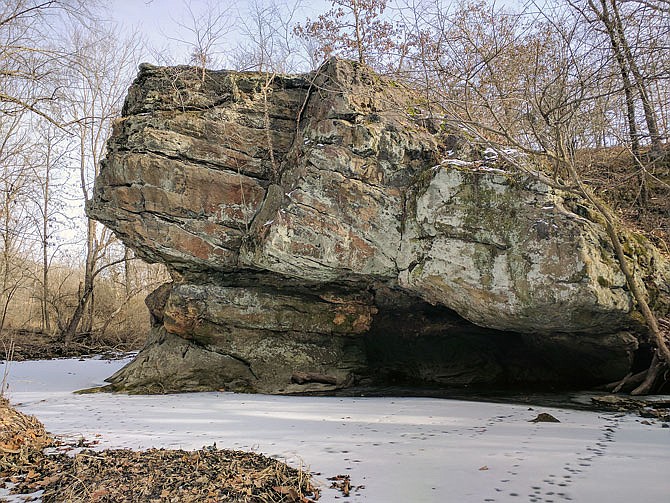As an Appalachian Trail hiker, Missouri Department of Conservation naturalist Lisa Richter knows a thing or two about backpacking.
She shared some of that knowledge during a virtual talk Friday afternoon.
"Hiking is a great way to make fun memories and get away from the city for a while, and there's some amazing places here in Missouri that are best appreciated on foot," Richter said.
The months between November and mid-April can be a surprisingly good time to hike, she said. Fewer people hit the trails in the winter, and bugs and poison ivy foliage die off.
A dayhike is a hike that's complete in a single day. Backpacking involves bringing along supplies and equipment for a multi-day hike and camping overnight.
Preparing for your hike
Richter said careful planning is key for staying safe and comfortable while backpacking - especially during the winter.
"Research where you're going and if it's open, and hunting seasons," she said.
Different parks also have different regulations regarding camping and packing out waste.
The Missouri Department of Conservation website has information about each conservation area, while information about Missouri's state parks can be found here. For detailed information about local conditions and any managed hunts or special hunting seasons, you can contact the county conservation agent.
For up-to-date information about trail conditions, check out AllTrails.com, where hikers can review the trails they travel. And keep an eye on the weather.
Choosing the proper equipment is an laborious process, but it's one that can make the difference between a fun hike and a miserable, shivering, blister-filled outing. Spend time researching and seeking the right backpack, sleeping bag, tent and boots.
Richter suggested investing in a down-insulated sleeping bag, even though they're more expensive.
"They last longer," she explained. "I'm going to have a warm bag for a decade or two decades, rather than five to six years"
To save money, look for used equipment in good condition on sites such as Ebay and Etsy.
Staying dry and staying warm go hand-in-hand, Richter said.
"I hate wet feet while I'm hiking," she said.
She recommended having waterproof boots and a lightweight, waterproof outer layer to keep your puffy coat dry. Wearing multiple layers makes adjusting for changing weather conditions and exertion easier. Richter keeps an eye out for used cashmere sweaters at thrift stores: They're light but comfy and warm even when wet.
In addition to those basics, backpackers should make sure to have a map and compass (a GPS unit can also be useful), a first-aid kit, and equipment or chemicals to filter and purify water. Packing enough food, and protecting it from critters, is also important.
"You may not have bears, but you might have a lot of raccoons around," Richter said.
To keep food away from hungry wildlife, store all good-smelling items (including scented toiletries) in a bag, tie the end of a rope to its handle, and tie the other end of the rope around a rock. Hurl the rock over a tree limb and hoist the bag until it's too far off the ground for animals to reach, but not close enough to the limb that a reaching raccoon could grab it from above.
"For flying squirrels, it doesn't work very well," Richter said. "They'll chew right through the bag and eat all your food. They like cookies."
But don't let too much packing weigh you down. The rule of thumb: A hiker can carry 1/4 of their body weight comfortably, and should carry no more than 1/3 of their own weight.
Before departing on your trip, make a plan for if you run into trouble.
"Let someone else know where you're going and when and when you plan to be back," Richter said.
That person can contact local authorities to start rescue efforts if you don't show up on time.
Recommended hikes
Richter listed a few of her top backpacking trails and areas in Missouri.
Near Kansas City, she recommends the Davidsdale, Monkey Mountain, Big Buffalo Creek and Rudolf Bennett conservation areas.
She also shouted out an option closer to Callaway County: The Cedar Creek trail system, which straddles the Callaway and Boone County line.
There are multiple trail loops in the system, including the 22-mile southern loop, the 6-mile moon loop and the 6-mile Smith Creek Loop.
"Smith Creek loop is really good size for an overnight backpacking trail," she said, mentioning the views from the bluffs above Cedar Creek.
However, the trail system is also popular with horse back riders - be prepared for muddy and rough trails when hiking after a rain.
Another nearby, beginner-friendly trail system is Ha Ha Tonka State Park at the Lake of the Ozarks. With multiple trail loops, a natural bridge and a ruined castle on a bluff, the park is a good destination for both day hikes and backpacking.
For more challenging options, Callaway County locals will have to do a little driving.
Richter recommended Big Piney Trail (16 miles, Paddy Creek Wilderness) and Courtois Creek Trail (Huzzah Conservation Area) as moderately difficult hikes.
The 12.3-mile Taum Sauk Trail (Taum Sauk Mountain State Park) and the 11.8-mile Mudlick Trail (Tom A. Baker State Park) are Richter's favorite difficult trails. Both feature Missouri's natural scenery at its finest - Tom Sauk with glades and Missouri's tallest waterfall and Mudlick with undisturbed old-growth forest.
"It's rated difficult, but you're going to see things you can't see in an easier-to-get-to park," she said.
Richter's full talk can be viewed here. To view and register for upcoming MDC virtual events, visit mdc.mo.gov/events.

